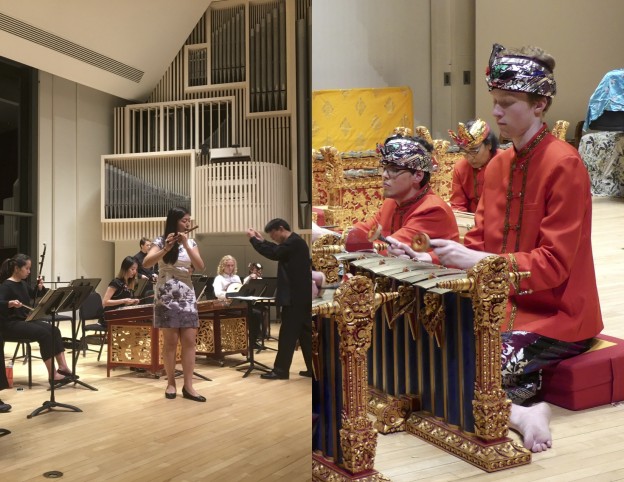When asked what they hope students get out of participating in their respective music ensembles, Professors Lei Ouyang Bryant and Tom Whitman both make reference to communal music-making as a way to escape the numerous pressures experienced by a typical Swarthmore student. “I think it is great for Swatties to play music for two to four hours a week amidst the rest of their busy schedules,” says Bryant, co-director of the Chinese Music Ensemble (CME). Whitman, co-director of Gamelan Semara Santi (Gamelan), which plays music from Bali, Indonesia, puts it a bit more bluntly: “It is my hope that students find in Gamelan a place to rid themselves of the stress that is endemic at Swarthmore.”
Beyond just stress relief, though, Bryant and Whitman hope that their respective groups provide space for community members to either explore a different music culture or celebrate and recognize their own. Whitman runs Gamelan rehearsals “Indonesian style—without any notation, and with minimal talking or analysis. I’d like our sessions to create a safe space where students can learn about Balinese culture by doing, rather than by reading or talking.” For her part, Bryant sees the CME “as a valuable site on campus where Asian students, Asian American students, and students interested in Chinese culture can work together and find community with each other.”
Enthusiasm for such a community is evident in the fact that enrollment in CME has more than doubled in its first three semesters. The ensemble is open to all, although most of this semester’s 25 members came in with some musical training. However, few had experience with traditional Chinese instruments such the guzheng (zither), erhu (bowed fiddle), pipa (plucked lute), yangqin (hammered dulcimer) or dizi (flute). Bryant’s co-director Guowei Wang, a Shanghai-born erhu artist, arranges folk songs and more recent Chinese and Taiwanese compositions to tailor them to the specific skill levels and talents of the current crop of students. Bryant describes the CME as “so fortunate to have [Wang] co-directing the ensemble and developing repertoire that everyone, from beginner to advanced, can play within one semester of study.”
Gamelan is also open to students—and Swarthmore community members—regardless of musical background, and is perhaps slightly more accessible to newbies due to the percussive nature of its instruments, which consist of mostly bronze-keyed xylophones, gongs, and drums. But while hitting a gong might as a technical act be a bit easier than playing a fiddle, for example, the overall musical product is quite complicated, with each person playing an essential rhythmic role. Says senior Aly Ye, who has been a part of Gamelan for all of her four years at Swarthmore, “I love the complexity of the music and the challenge of learning it together, part by part, as an ensemble.” The tightly interwoven percussive parts result in a soundscape that is, according to Whitman, a “beautiful texture of different layers.”
Another non-sound layer is sometimes added to the mix when Gamelan pieces are accompanied by dance. Whitman explains that, “in Bali, dance and music are two facets of the same coin,” and that “while there are many pieces of instrumental music that do not accompany dance, all are informed by the spirit and many specific techniques from Balinese dance.” This close relationship has been evident to Ye, who will dance and play in the upcoming show. She says that “because the dance is so closely tied to the music, I feel like I’ve gained deeper insight into why the music moves and changes in the way that it does…. there are many times when something is emphasized in the music that, when I’m learning the dance, suddenly make more sense.” Whitman states that his lack of dance training is “one of my biggest weaknesses as a gamelan director. But we are extremely fortunate that our co-directors, I Nyoman Suadin and Latifah Alsegaf, come to campus. They bring to our ensemble that dimension of dance that I am not competent to teach.”
Audiences can come experience this auditory and visual feast in person on Sunday, December 2nd at 3pm, in the Chinese Music Ensemble and Gamelan Semara Santi’s combined end-of-semester concert. The performance will be held in Lang Concert Hall and is free and open to the public. Families are welcome!
Lydia Roe ’20
